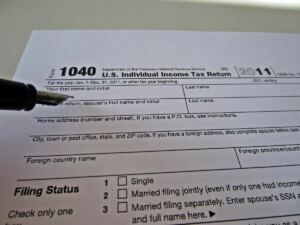IRS Warns Taxpayers to Adjust Withholding Now or Face the Consequences
The Internal Revenue Service (IRS) has issued a warning to taxpayers, urging them to review and adjust their tax withholding as soon as possible to avoid potential surprises when filing their tax returns. Failure to do so may result in penalties, interest, or even financial hardship.
Having too much tax withheld throughout the year effectively means you are giving the government an interest-free loan. Surprisingly, the IRS estimates that approximately 70% of taxpayers overpay their taxes, resulting in a refund at tax time. By adjusting your withholding, you can retain more of your hard-earned money throughout the year.
On the other hand, if you don’t have enough taxes withheld from your paychecks, you may end up owing a balance when you file your taxes. This can be a significant financial burden, especially if you are already struggling to make ends meet. Owing a balance can lead to penalties, interest, and even negative impacts on your credit score.
To determine if you have the right amount of tax withheld from your paychecks, the IRS offers an online tool called the Tax Withholding Estimator. This user-friendly tool allows wage-earning taxpayers to calculate if they are on track to receive a refund or if they need to make additional payments to avoid owing taxes and potential penalties in the following year.
1. Review Your Current Withholding Status
As the end of the year approaches, take the time to review your current tax withholding status. This will give you a baseline understanding of whether adjustments are necessary. Keep in mind that it’s best to verify your withholding early in the year, but even adjustments made in the final weeks of the year can have a positive impact.
2. Assess Your Financial Circumstances
To make accurate adjustments, it’s crucial to assess your financial circumstances. Consider factors such as changes in income, new dependents, major life events, or any other relevant changes that may impact your tax liability. By having a clear understanding of your financial situation, you can make informed decisions regarding your tax withholding.
3. Use the Tax Withholding Estimator
Utilize the Tax Withholding Estimator provided by the IRS. This tool will guide you through a series of questions to determine the appropriate amount of tax to withhold from your paychecks. Be prepared to provide information such as your income, deductions, credits, and other relevant details.
4. Adjust Your Withholding
Based on the results of the Tax Withholding Estimator, you may need to adjust your tax withholding. This can be done by submitting a new Form W-4 to your employer. The form provides instructions on how to calculate the appropriate number of allowances to claim, ensuring that the right amount of tax is withheld from your paychecks.
5. Consider Quarterly Estimated Tax Payments
If you earn income that is not subject to withholding, such as self-employment income or income from the gig economy, you may need to make quarterly estimated tax payments to avoid owing a balance at tax time. Form 1040-ES can be used to make these payments, and it is essential to keep track of your payment history and tax records.
Consequences of Incorrect Tax Withholding
Penalties and Interest
Incorrect tax withholding can result in penalties and interest. If you owe a balance when filing your taxes, the IRS charges interest on any unpaid taxes starting from the original due date of the return. Additionally, penalties may be assessed if you fail to file your return on time or if you owe taxes but fail to pay them by the deadline. It’s important to avoid these consequences by ensuring accurate tax withholding.
Negative Effects on Credit Score
Owing a balance at tax time can have negative effects on your credit score. Unpaid taxes are considered debts, and failing to pay them can lead to wage garnishments, liens on property, and other legal actions. Protect your credit score by adjusting your tax withholding to avoid owing a balance.
In addition to adjusting your tax withholding, it’s essential to stay informed about changes in retirement contribution limits. The IRS recently announced increases in contribution limits for retirement plans, allowing taxpayers to boost their tax-free savings.
401(k), 403(b), and 457 Plans
The contribution limit for employees participating in 401(k), 403(b), and most 457 plans, as well as the federal government’s Thrift Savings Plan, has been increased to $23,000, up from $22,500. This increase provides an opportunity to save more for retirement and potentially reduce your taxable income.
Individual Retirement Accounts (IRA)
The limits on annual contributions to an IRA have also been raised. Individuals can now contribute up to $7,000, up from $6,500. This increase allows for additional tax-free savings and potential tax benefits.

Catch-Up Contributions
For individuals aged 50 and above, catch-up contributions are available for both IRA accounts and 401(k) plans. These additional contributions are designed to bolster retirement savings for individuals closer to retirement age. The catch-up contribution for IRA accounts remains at $1,000, while for 401(k) accounts, it is $7,500.
While the IRS has increased contribution limits for retirement savings accounts, recent data indicates a concerning trend. More Americans are withdrawing money from their retirement accounts due to financial hardship. According to a Bank of America analysis, the number of hardship withdrawals from 401(k) accounts has been increasing steadily.
In the second quarter of this year, 15,950 people made hardship withdrawals, representing a 12% increase from the first quarter and a 36% increase from the third quarter of the previous year. This trend highlights the importance of proper financial planning and the need to protect retirement savings.

